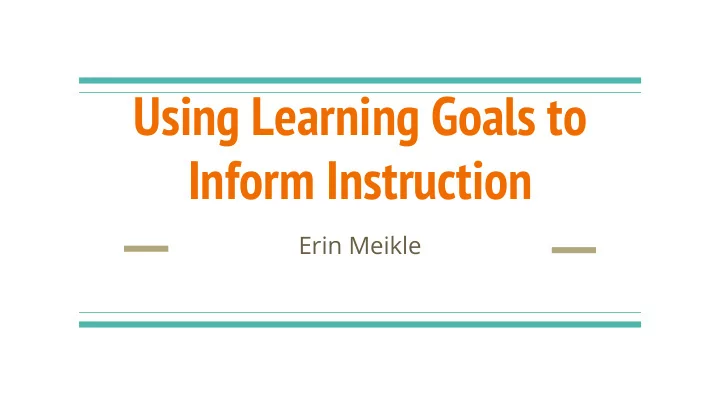

Using Learning Goals to Inform Instruction Erin Meikle
Overview What we mean by learning goals Specifying learning goals Why learning goals are important
What are learning goals?
e.g., Students will be able to complete the following task by Conceptual learning goals the end of the lesson. are not about performance Write a story problem to represent the following (Hiebert et al., 2007). number sentence and use a picture to solve the problem. 14X6=?
Conceptual learning goals Procedural learning goal: are more than Students will understand how to compare fractions. understanding “how” to do Conceptual learning goal: something Students will understand that the numerator represents the number of pieces and the denominator represents the size of the pieces.
e.g., Students will understand the repeated Learning goals are about addition meaning of multiplication the content teachers want 1. In the number students to understand (Hiebert sentence aXb=c, a represents the number et al., 2007). of groups of a certain size, b represents the size of the groups, and c represents the total. 2. The size of the groups must be the same.
Some learning goals are not specified enough to distinguish conceptual from Students will be able to explain procedural understanding why the common denominator (Stein & Meikle, 2017) algorithm works for subtraction of fractions.
Students will be able to explain why the common denominator Some learning goals are not algorithm works for specified enough to subtraction of fractions. distinguish conceptual from To be able to add two ● procedural understanding fractions, we need same-sized pieces to be (Stein & Meikle, 2017) able to compare them Once the fractions are ● written in terms of the same-sized pieces, we can then compare the numerators because they are of the same size.
Teachers have other types e.g., social justice goals of goals for students (Lampert, “Relating math to all cultures 2001) so students can be involved” (Bartell, 2013, p. 139).
Rate Problem - Solve Joe, Sarah, and Alex each counted 30 beans. Joe took 20 seconds. Sarah took 24 seconds. Alex took 15 seconds. Who was fastest? Taken from Inside Mathematics (http://www.insidemathematics.org/classroom-videos/public-lessons/6th-grade-math-rates-lipman/lesson-part- 2)
Rate Problem - Write learning goal(s) Joe, Sarah, and Alex each counted 30 beans. Joe took 20 seconds. Sarah took 24 seconds. Alex took 15 seconds. Who was fastest? Taken from Inside Mathematics (http://www.insidemathematics.org/classroom-videos/public-lessons/6th-grade-math-rates-lipman/lesson-part- 2)
What are Mr. C’s learning goals? Use students’ responses and work to specify Mr. C’s learning goal. Video Link Taken from Inside Mathematics (http://www.insidemathematics.org/classroom-videos/public-lessons/6th-grade-math-rates-lipman/lesson-part-2)
What are Mr. C’s learning goals? What do you notice about your learning goal statements for Mr. C’s lesson compared to the learning goals you initially wrote? Video Link Taken from Inside Mathematics (http://www.insidemathematics.org/classroom-videos/public-lessons/6th-grade-math-rates-lipman/lesson-part- 2)
Diagnose student understanding (Hiebert, Morris, & Spitzer, in press).. Look for evidence of the learning goal in student work or verbal responses and then use this evidence to refine the learning goal (Hiebert, Morris, & Spitzer, in press) Use curricular materials or draw on expertise from colleagues to refine the learning goal (Drake, Land, & Tyminski, 2014; Stein & Meikle, 2017)
Why are learning goals important?
Drive instruction (Stein & Meikle, 2017). Selecting tasks e.g., Students explore a high cognitive demand task. The Selecting solution strategies to be teacher monitors students’ work shared and purposefully selects strategies to be shared that have Constructing questions the greatest chance of promoting Constructing assessments (informal the learning goal(s). or formal)
Develop mathematical knowledge for teaching (Ball, Thames, & Phelps, 2008). Connect goals across lessons Sequence tasks Predict students’ solutions to tasks Understand how students learn concepts over time (Stein & Meikle, 2017)
Diagnose student understanding (Hiebert, Morris, & Spitzer, in press).. Modify future implementations of lessons Modify subsequent instruction based on students’ current understanding Identify students’ current understandings rather than just quantifying their performance
Using learning goals to facilitate whole-class discussions
Orange juice task - Solve the Task in as many ways as you can Task taken from https://connectedmath.msu.edu/tea cher-support/student-work/student- work-from-comparing-scaling-probl em-1-2-making-juice/
Five practices for orchestrating class discussions (Stein, Engle, Smith, & Hughes, 2008; Stein & Smith, 2011) 0. Selecting a task and specifying a learning goal 1. Anticipating 2. Monitoring 3. Selecting 4. Sequencing 5. Connecting
Analyze solutions for evidence of the learning goal and decide which 4 you would select Do not consider how you would sequence the solutions yet! Task and solutions taken from https://connectedmath.msu.edu/tea cher-support/student-work/student- work-from-comparing-scaling-probl em-1-2-making-juice/
Sequence the selected solutions based on connections you want to make between them Write your selecting and sequencing decisions on the poster. Task and solutions taken from https://connectedmath.msu.edu/tea cher-support/student-work/student- work-from-comparing-scaling-probl em-1-2-making-juice/
Selecting, sequencing and connecting Some solution strategies highlight the concepts underlying the learning goals better than others (Meikle, under review; see Peterson & Leatham, 2009) Pre-service teachers sometimes select and sequence olution strategies for other reasons and then some of the concepts underlying the learning goal can be missed (Meikle, 2014; Meikle, 2016) Connections between solution strategies can inform the sequence (Meikle, 2016)
Analysis-of-teaching skills (Hiebert, Morris, Berk, & Jansen, 2007) Specify a learning goal Collect evidence Construct hypotheses Make revisions Refine the learning goal
Analysis-of-teaching skills (Hiebert, Morris, Berk, & Jansen, 2007) Specify a learning goal Collect evidence Construct hypotheses Make revisions Refine the learning goal
How would you refine the learning goal to the OJ task?
Recommend
More recommend